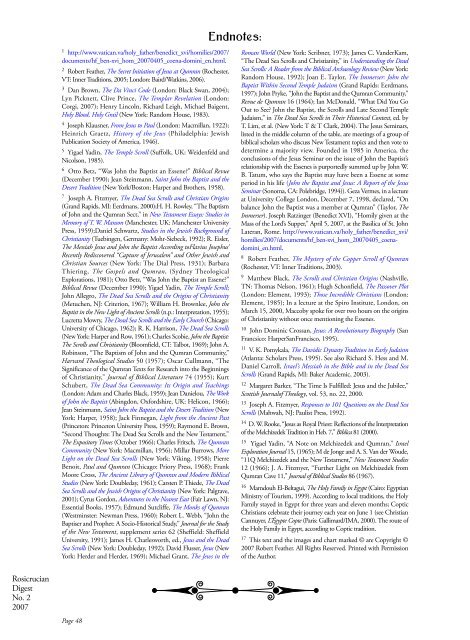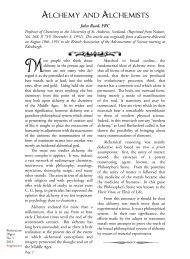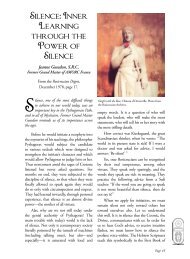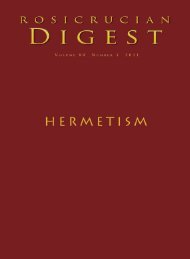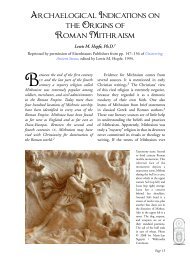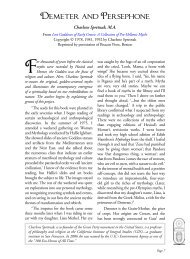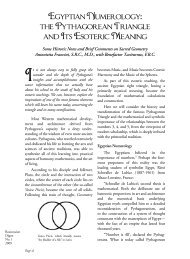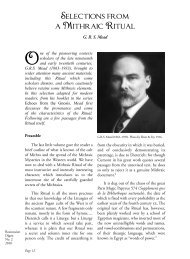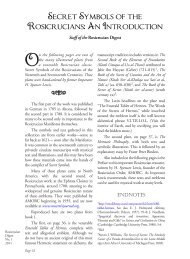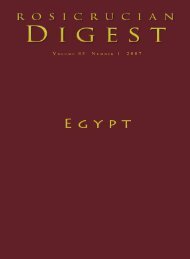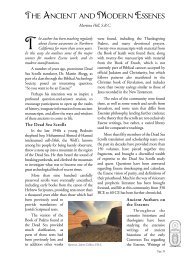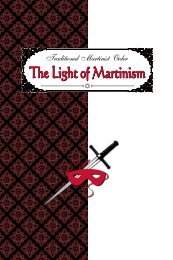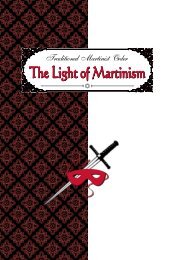Rosicrucian Digest Vol 85 Number 2 2007 - Rosicrucian Order
Rosicrucian Digest Vol 85 Number 2 2007 - Rosicrucian Order
Rosicrucian Digest Vol 85 Number 2 2007 - Rosicrucian Order
You also want an ePaper? Increase the reach of your titles
YUMPU automatically turns print PDFs into web optimized ePapers that Google loves.
1 http://www.vatican.va/holy_father/benedict_xvi/homilies/<strong>2007</strong>/<br />
documents/hf_ben-xvi_hom_<strong>2007</strong>0405_coena-domini_en.html.<br />
2 Robert Feather, The Secret Initiation of Jesus at Qumran (Rochester,<br />
VT: Inner Traditions, 2005; London: Baird/Watkins, 2006).<br />
3 Dan Brown, The Da Vinci Code (London: Black Swan, 2004);<br />
Lyn Picknett, Clive Prince, The Templar Revelation (London:<br />
Corgi, <strong>2007</strong>); Henry Lincoln, Richard Leigh, Michael Baigent,<br />
Holy Blood, Holy Grail (New York: Random House, 1983).<br />
4 Joseph Klausner, From Jesus to Paul (London: Macmillan, 1922);<br />
Heinrich Graetz, History of the Jews (Philadelphia: Jewish<br />
Publication Society of America, 1946).<br />
5 Yigael Yadin, The Temple Scroll (Suffolk, UK: Weidenfeld and<br />
Nicolson, 19<strong>85</strong>).<br />
6 Otto Betz, “Was John the Baptist an Essene?” Biblical Revue<br />
(December 1990); Jean Steinmann, Saint John the Baptist and the<br />
Desert Tradition (New York/Boston: Harper and Brothers, 1958).<br />
7 Joseph A. Fitzmyer, The Dead Sea Scrolls and Christian Origins<br />
(Grand Rapids, MI: Eerdmans, 2000);H. H. Rowley, “The Baptism<br />
of John and the Qumran Sect,” in New Testament Essays: Studies in<br />
Memory of T. W. Manson (Manchester, UK: Manchester University<br />
Press, 1959);Daniel Schwartz, Studies in the Jewish Background of<br />
Christianity (Tuebingen, Germany: Mohr-Siebeck, 1992); R. Eisler,<br />
The Messiah Jesus and John the Baptist According toFlavius Josephus’<br />
Recently Rediscovered “Capture of Jerusalem” and Other Jewish and<br />
Christian Sources (New York: The Dial Press, 1931); Barbara<br />
Thiering, The Gospels and Qumran, (Sydney Theological<br />
Explorations, 1981); Otto Betz, “Was John the Baptist an Essene?”<br />
Biblical Revue (December 1990); Yigael Yadin, The Temple Scroll;<br />
John Allegro, The Dead Sea Scrolls and the Origins of Christianity<br />
(Metuchen, NJ: Criterion, 1967); William H. Brownlee, John the<br />
Baptist in the New Light of Ancient Scrolls (n.p.: Interpretation, 1955);<br />
Lucretta Mowry, The Dead Sea Scrolls and the Early Church (Chicago:<br />
University of Chicago, 1962); R. K. Harrison, The Dead Sea Scrolls<br />
(New York: Harper and Row, 1961); Charles Scobie, John the Baptist:<br />
The Scrolls and Christianity (Bloomfield, CT: Talbot, 1969); John A.<br />
Robinson, “The Baptism of John and the Qumran Community,”<br />
Harvard Theological Studies 50 (1957); Oscar Cullmann, “The<br />
Significance of the Qumran Texts for Research into the Beginnings<br />
of Christianity,” Journal of Biblical Literature 74 (1955); Kurt<br />
Schubert, The Dead Sea Community: Its Origin and Teachings<br />
(London: Adam and Charles Black, 1959); Jean Danielou, The Work<br />
of John the Baptist (Abingdon, Oxfordshire, UK: Helicon, 1966);<br />
Jean Steinmann, Saint John the Baptist and the Desert Tradition (New<br />
York: Harper, 1958); Jack Finnegan, Light from the Ancient Past<br />
(Princeton: Princeton University Press, 1959); Raymond E. Brown,<br />
“Second Thoughts: The Dead Sea Scrolls and the New Testament,”<br />
The Expository Times (October 1966); Charles Fritsch, The Qumran<br />
Community (New York: Macmillan, 1956); Millar Burrows, More<br />
Light on the Dead Sea Scrolls (New York: Viking, 1958); Pierre<br />
Benoit, Paul and Qumran (Chicago: Priory Press, 1968); Frank<br />
Moore Cross, The Ancient Library of Qumran and Modern Biblical<br />
Studies (New York: Doubleday, 1961); Carsten P. Thiede, The Dead<br />
Sea Scrolls and the Jewish Origins of Christianity (New York: Palgrave,<br />
2001); Cyrus Gordon, Adventures in the Nearest East (Fair Lawn, NJ:<br />
Essential Books, 1957); Edmund Sutcliffe, The Monks of Qumran<br />
(Westminster: Newman Press, 1960); Robert L. Webb, “John the<br />
Baptiser and Prophet: A Socio-Historical Study,” Journal for the Study<br />
of the New Testament, supplement series 62 (Sheffield: Sheffield<br />
University, 1991); James H. Charlesworth, ed., Jesus and the Dead<br />
Sea Scrolls (New York: Doubleday, 1992); David Flusser, Jesus (New<br />
York: Herder and Herder, 1969); Michael Grant, The Jews in the<br />
Roman World (New York: Scribner, 1973); James C. VanderKam,<br />
“The Dead Sea Scrolls and Christianity,” in Understanding the Dead<br />
Sea Scrolls: A Reader from the Biblical Archaeology Review (New York:<br />
Random House, 1992); Joan E. Taylor, The Immerser: John the<br />
Baptist Within Second Temple Judaism (Grand Rapids: Eerdmans,<br />
1997); John Pryke, “John the Baptist and the Qumran Community,”<br />
Revue de Qumran 16 (1964); Ian McDonald, “What Did You Go<br />
Out to See? John the Baptist, the Scrolls and Late Second Temple<br />
Judaism,” in The Dead Sea Scrolls in Their Historical Context, ed. by<br />
T. Lim, et al. (New York: T & T Clark, 2004). The Jesus Seminars,<br />
listed in the middle column of the table, are meetings of a group of<br />
biblical scholars who discuss New Testament topics and then vote to<br />
determine a majority view. Founded in 19<strong>85</strong> in America, the<br />
conclusions of the Jesus Seminar on the issue of John the Baptist’s<br />
relationship with the Essenes is purportedly summed up by John W.<br />
B. Tatum, who says the Baptist may have been a Essene at some<br />
period in his life (John the Baptist and Jesus: A Report of the Jesus<br />
Seminar (Sonoma, CA: Polebridge, 1994)). Geza Vermes, in a lecture<br />
at University College London, December 7, 1998, declared, “On<br />
balance John the Baptist was a member at Qumran” (Taylor, The<br />
Immerser). Joseph Ratzinger (Benedict XVI), “Homily given at the<br />
Mass of the Lord’s Supper,” April 5, <strong>2007</strong>, at the Basilica of St. John<br />
Lateran, Rome. http://www.vatican.va/holy_father/benedict_xvi/<br />
homilies/<strong>2007</strong>/documents/hf_ben-xvi_hom_<strong>2007</strong>0405_coenadomini_en.html.<br />
8 Robert Feather, The Mystery of the Copper Scroll of Qumran<br />
(Rochester, VT: Inner Traditions, 2003).<br />
9 Matthew Black, The Scrolls and Christian Origins (Nashville,<br />
TN: Thomas Nelson, 1961); Hugh Schonfield, The Passover Plot<br />
(London: Element, 1993); Those Incredible Christians (London:<br />
Element, 19<strong>85</strong>); In a lecture at the Spiro Institute, London, on<br />
March 15, 2000, Maccoby spoke for over two hours on the origins<br />
of Christianity without once mentioning the Essenes.<br />
10 John Dominic Crossan, Jesus: A Revolutionary Biography (San<br />
Francsico: HarperSanFrancisco, 1995).<br />
11 V. K. Pomykala, The Davidic Dynasty Tradition in Early Judaism<br />
(Atlanta: Scholars Press, 1995). See also Richard S. Hess and M.<br />
Daniel Carroll, Israel’s Messiah in the Bible and in the Dead Sea<br />
Scrolls (Grand Rapids, MI: Baker Academic, 2003).<br />
12 Margaret Barker, “The Time Is Fulfilled: Jesus and the Jubilee,”<br />
Scottish Journalof Theology, vol. 53, no. 22, 2000.<br />
13 Joseph A. Fitzmyer, Responses to 101 Questions on the Dead Sea<br />
Scrolls (Mahwah, NJ: Paulist Press, 1992).<br />
14 D. W. Rooke, “Jesus as Royal Priest: Reflections of the Interpretation<br />
of the Melchizedek Tradition in Heb. 7,” Biblica 81 (2000).<br />
15 Yigael Yadin, “A Note on Melchizedek and Qumran,” Israel<br />
Exploration Journal 15, (1965); M de Jonge and A. S. Van der Woude,<br />
“11Q Melchizedek and the New Testament,” New Testament Studies<br />
12 (1966); J. A. Fitzmyer, “Further Light on Melchizedek from<br />
Qumran Cave 11,” Journal of Biblical Studies 86 (1967).<br />
16 Mamdouh El-Beltagui, The Holy Family in Egypt (Cairo: Egyptian<br />
Ministry of Tourism, 1999). According to local traditions, the Holy<br />
Family stayed in Egypt for three years and eleven months; Coptic<br />
Christians celebrate their journey each year on June 1 (see Christian<br />
Cannuyer, L’Égypte Copte (Paris: Gallimard/IMA, 2000). The route of<br />
the Holy Family in Egypt, according to Coptic tradition.<br />
17 This text and the images and chart marked © are Copyright ©<br />
<strong>2007</strong> Robert Feather. All Rights Reserved. Printed with Permission<br />
of the Author.<br />
<strong>Rosicrucian</strong><br />
<strong>Digest</strong><br />
No. 2<br />
<strong>2007</strong><br />
Page 48


